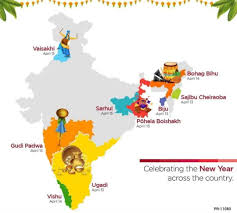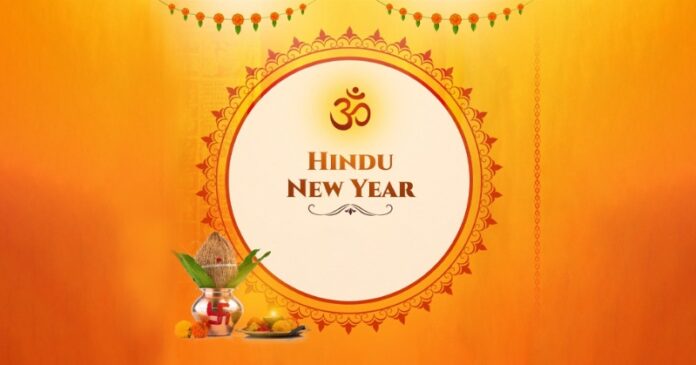There’s a unique kind of silence that fills the early morning air on 14 April, the kind that carries promise. It’s not the hush of a regular morning. It’s a new beginning.
In many parts of India, 14 April marks the Hindu New Year, and while the rest of the world may pin its hopes on 1 January, we like to take our cue from the Sun, specifically when it moves into Mesha Rashi (Aries). This cosmic event, known as Mesha Sankranti, kicks off a brand-new year in many Indian calendars.
It’s fascinating when you think about it. Isn’t this a bit like launching a spaceship? A well-timed event, based on planetary alignments, that sets the course for everything that follows. Which got me thinking, space tourism, commercial space travel, and the future of space travel aren’t that different from how we approach festivals in India. Both are rooted in deep planning, cosmic rhythms, and a shared sense of awe.
So, come along as we journey across India to explore 10 beautiful ways the Hindu New Year is celebrated on April 14, and how this ancient tradition is surprisingly relevant in our futuristic world.
Why 14 April? The Cosmic Reset

Before we look into the festive fun, let’s understand the “why.” Unlike the Gregorian New Year, which is man-made and fixed, the Hindu New Year in April is cosmic. It’s all about the sun moving into Aries, the first zodiac sign, symbolic of courage, action, and new energy.
It’s a reset based on solar transit, one that multiple regions across India recognize as the ideal moment to reboot life.
It’s like how astronauts wait for perfect orbital alignment to launch. In a way, we’re all launching ourselves into a new personal orbit each year.
10 Celebrations, One Spirit: Hindu New Year Traditions Across India
Let’s pack our virtual bags and travel across 10 Indian states to witness how each one celebrates 14 April, with all its color, community, and cosmic charm.
1. Puthandu (Tamil Nadu)
In Tamil Nadu, the New Year is known as Puthandu, and it begins with the soothing clang of bells and the scent of jasmine in the air.
I remember spending a Puthandu with my friend Aarthi in Chennai. Her mom served us mango pachadi, a strange yet addictive mix of sweet jaggery, tangy raw mango, bitter neem flowers, and a kick of chili. She said, “This dish is life in a bowl, bitter, sweet, sour, and spicy.”
Traditions Include:
- Early morning bath and visit to the temple
- Drawing kolam (rangoli) at the doorstep
- Gifting money (kai neettal) to kids
2. Vishu (Kerala)
Down in Kerala, the air on Vishu morning carries a golden glow. Why? Because of the Vishu Kani, an elaborate arrangement of rice, fruits, flowers, mirror, and gold, prepared the night before.
The idea is to wake up and see something auspicious first thing, so your entire year follows the same positive path. Now that’s manifestation, desi style.
Highlights:
- Elders gift money (Vishukkaineettam)
- Firecrackers and feasting
- Prayers to Lord Vishnu
3. Poila Boishakh (West Bengal)
Bengalis love a good celebration, and Poila Boishakh, or Bengali New Year, is no exception.
Business owners start the year with a clean slate by opening new Haal Khatas, account books blessed with rituals. Sweet shops brim with rosogollas, mishti doi, and the intoxicating scent of fresh mango leaves.
Celebratory Touches:
- Wearing traditional red-and-white outfits
- Visiting Dakshineswar or Kalighat temples
- Cultural performances of Rabindra Sangeet
4. Baisakhi (Punjab)
Baisakhi is when every heartbeat echoes with a dhol beat. For Punjabis, it’s both the harvest festival and the Sikh New Year. I once danced in a community Baisakhi event in Delhi and came home sore but incredibly alive.
Baisakhi Scenes:
- Holy dips in rivers
- Gurdwara processions and langar
- High-energy Bhangra and Gidda

5. Bohag Bihu (Assam)
The spirit of Rongali Bihu, or Bohag Bihu, is infectious. It’s not just a new year, it’s a celebration of spring, love, and life itself.
Picture this: young boys playing pepa (a bamboo wind instrument), girls in red and white Mekhela Chadors, and every household cooking pitha and laru.
Bihu Highlights:
- Honoring cattle with baths and turmeric
- Folk dances under the open sky
- Community feasts and love songs
6. Maha Vishuba Sankranti (Odisha)
In Odisha, this day is celebrated as Maha Vishuba Sankranti, and it marks the beginning of the Odia calendar year. Locally known as Pana Sankranti, it comes with a delicious tradition.
Also Read: Why Maha Vishuba Sankranti is Also Called Pana Sankranti?
People prepare ‘Bela Pana’, a cooling drink made from wood apple, milk, jaggery, banana, and pepper, a true elixir for the summer heat.
Other Unique Customs:
- Ritual bath in rivers
- Visiting temples like Lingaraj in Bhubaneswar
- Charity and donation to Brahmins
Fun fact: The Meru Yatra is observed around this time in Odisha, a symbolic pilgrimage toward spiritual elevation. Sounds a bit like preparing for a space voyage, doesn’t it?
7. Vaisakha Sankranti (Uttar Pradesh & Bihar)
In northern India, especially Uttar Pradesh and Bihar, the solar new year is observed as Vaisakha Sankranti. While it’s not as grand as Holi or Diwali, it holds deep spiritual significance.
Most devotees perform Ganga snan (holy bath in the Ganges), visit temples, and offer food to the needy.
Simple Yet Sacred:
- Temple visits to Hanuman and Vishnu shrines
- Planting trees and tulsi as a ritual
- Fasting and donating food (Anna Daan)
8. Jur Sital (Mithila Region – Bihar/Jharkhand)
In the Mithilanchal region, this day is called Jur Sital, literally meaning “cool head.” It’s a summer-centric new year observed with cool water, simple foods, and blessings from elders.
Quirky Yet Heartwarming:
- Sprinkling cold water on elders’ feet as a mark of respect
- Eating kadhi-bhaat and aam panna
- Women sing Maithili songs, reminiscing old village life
9. Cheti Chand (Sindhi Community)
The Sindhi New Year, called Cheti Chand, usually coincides with Mesha Sankranti or falls slightly earlier in April. It celebrates the birth of Jhulelal, their water deity.
I once walked into a Cheti Chand fair in Ulhasnagar by accident, and let me tell you, it was unforgettable. Food stalls, traditional dances, and a spirit of togetherness that felt electric.
Rituals Include:
- Jhulelal aarti and bhajans
- Processions with water pots and diyas
- Community feasts of Sindhi curry and koki
10. Navreh (Kashmiri Pandits)
In Kashmir, the new year is celebrated as Navreh, a beautiful festival filled with symbolism. A thali of sacred items, rice, pen, mirror, herbs, and coins, is shown to family members as the first sight of the year.
This ritual is akin to planning your life mission like a space crew prepping their essentials before takeoff.
Navreh Traditions:
- Visiting Sharika Devi Temple
- Reading the new year’s almanac (Nachipatra)
- Writing goals for the year ahead
A Cultural Launchpad for the Future
You may be wondering, what do all these local traditions have to do with the future? A lot, actually.
The world today is obsessed with space tourism and commercial space travel. But at its core, space travel is about renewal, discovery, and perspective, the same values our ancient festivals are built on.
- Just like we chart our calendars based on solar events, NASA and ISRO calculate launch windows
- Just as we perform cleansing rituals, astronauts go through rigorous pre-flight purification
- Every Hindu New Year is a spiritual launchpad, and every space launch is a physical one
Isn’t that wild? Thousands of years ago, people in Tamil Nadu, Odisha, and Kashmir were already syncing their lives with cosmic events, long before we could even dream of commercializing them.
Blast Off into a Beautiful New Year
Whether you’re lighting a lamp in your Chennai home or sipping Bela Pana in Bhubaneswar, April 14 is a reminder to pause, reset, and reimagine. We don’t need a rocket ship to feel connected to the cosmos, we just need awareness, tradition, and a little bit of joy.
This year, I’ll be celebrating in a small but meaningful way, maybe a temple visit, a homemade dish, and some reflection on what I want to carry into my next orbit.
So, wherever you are, launch your own new beginning. Whether it’s a new hobby, a new resolution, or just a deeper appreciation of your roots, lift off.
Also Read: Jallianwala Bagh: The Day I Felt History Breathe
Who knows? Maybe in the not-so-distant future, we’ll celebrate Mesha Sankranti on Mars, courtesy of space tourism. But until then, Earth is doing a pretty spectacular job.
FAQs: Hindu New Year and More
1. Why does the Hindu New Year fall on 14 April in many states?
Because it coincides with the Sun’s transition into Mesha Rashi (Aries), marking the solar new year in many regional Hindu calendars.
2. Is 14 April a holiday everywhere in India?
No, it depends on the state. Some states officially declare it a holiday due to local traditions, like Tamil Nadu (Puthandu) or Punjab (Baisakhi), while others may not.
3. How is space tourism related to the Hindu New Year?
Both celebrate cosmic alignment and new beginnings. The Hindu New Year honors the sun’s transition, while space travel is guided by planetary movements, both are deeply rooted in celestial timing.
4. Which Indian state celebrates with Bela Pana?
Odisha celebrates Maha Vishuba Sankranti with Bela Pana, a traditional wood apple-based drink that symbolizes health and new beginnings.



